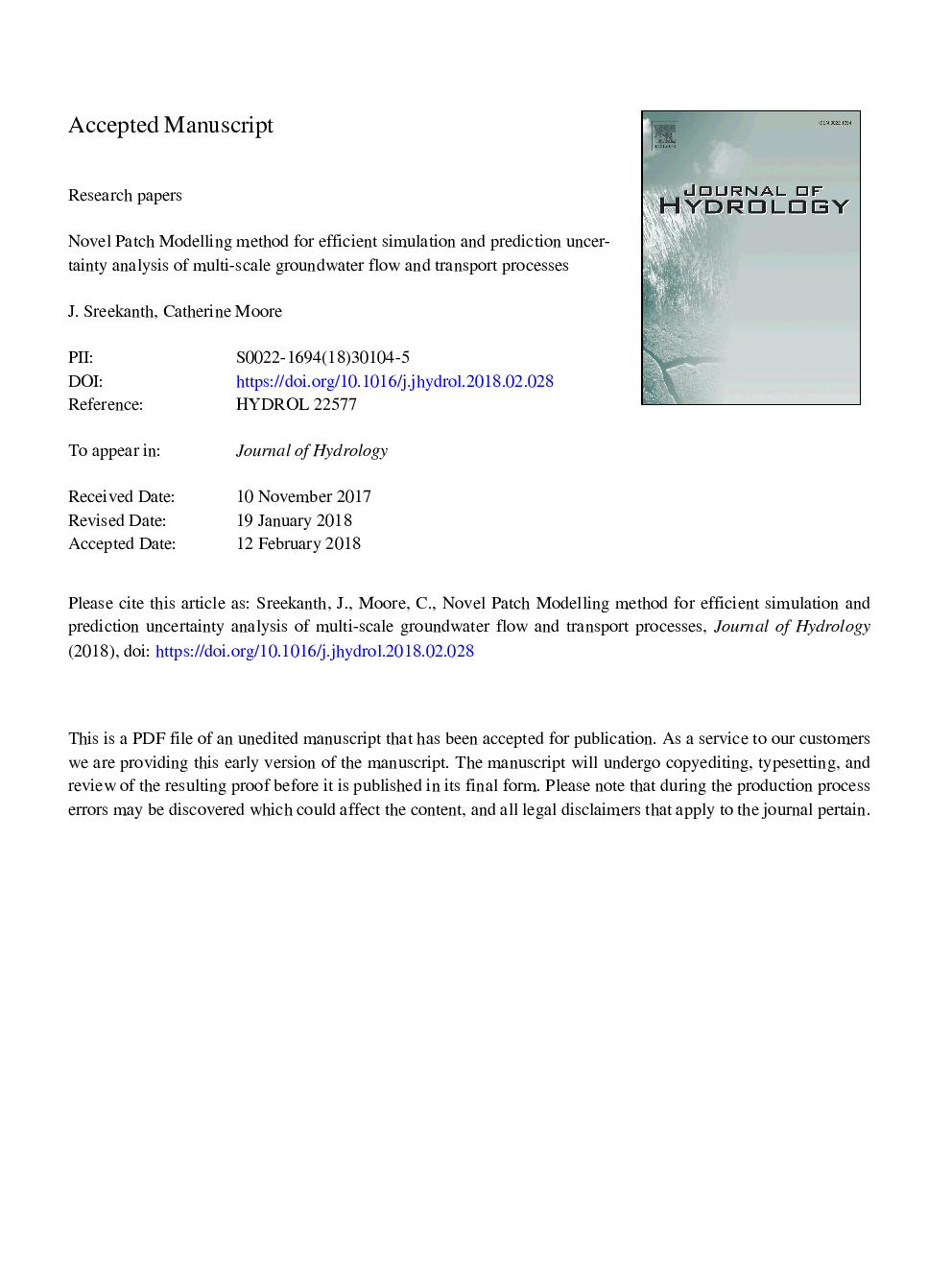| کد مقاله | کد نشریه | سال انتشار | مقاله انگلیسی | نسخه تمام متن |
|---|---|---|---|---|
| 8894872 | 1629895 | 2018 | 36 صفحه PDF | دانلود رایگان |
عنوان انگلیسی مقاله ISI
Novel patch modelling method for efficient simulation and prediction uncertainty analysis of multi-scale groundwater flow and transport processes
ترجمه فارسی عنوان
روش مدل سازی پچ های جدید برای شبیه سازی کارآمد و تجزیه و تحلیل عدم قطعیت پیش بینی جریان های جریان آب و فرآیندهای حمل و نقل چند مرحله
دانلود مقاله + سفارش ترجمه
دانلود مقاله ISI انگلیسی
رایگان برای ایرانیان
کلمات کلیدی
عدم اطمینان پیش بینی، آب های زیرزمینی، مدلسازی حمل و نقل، بالا بردن
ترجمه چکیده
استفاده از حساسیت جهانی و تکنیک های تجزیه و تحلیل عدم اطمینان به مدل های آبهای زیرزمینی حوضه های عمیق رسوبی به واسطه محاسبات سنگین همراه با مسائل مربوط به ثبات عددی مرتبط است. رویکردهای بسیار پارامتریک مورد نیاز برای بررسی عدم قطعیت پیش بینی شده با ویژگی های هیدروژنی ناهمگن چندین آبخوان و آکواریدها در این حوضه های رسوب، این مسائل را تشدید می کنند. یک روش جدید ردیابی پچ برای بهبود امکان سنجی محاسباتی از مدل سازی تصادفی مدل های مقیاس بزرگ و پیچیده آب های زیرزمینی ارائه شده است. این روش شامل چارچوب مدل سازی آبهای زیرزمینی است که امکان شبیه سازی کارایی جریان آب های زیرزمینی و حمل و نقل در مقیاس های مکانی و زمانی را فراهم می کند. این روش همچنین اجازه می دهد تا فرآیندهای مختلف در مقیاس های مختلف مدل شبیه سازی شود. روشهای موجود در مدل توزیع شده با استفاده از «پیش بینی پیوستن» برای استخراج اطلاعات پیش بینی شده از یک مدل به مقیاس بعدی، گسترش یافته است. این یک مکانیابی بازخوردی را ایجاد می کند که انتقال اطلاعات از مدل های فرزند به مدل های والدین و همچنین مدل های پدر و مادر را به مدل های کودک را به شیوه ای با کارایی محاسباتی تقویت می کند. این مکانیزم بازخورد ساده و انعطاف پذیر است و تضمین می کند که در حالیکه ویژگی های مقیاس قابل توجهی که بر پیش بینی مقیاس بزرگتری تاثیر می گذارند به مقیاس بزرگتر منتقل می شوند، این نیازی به پیوند زنده مدل ها نیست. این روش اجازه می دهد تا مدل سازی چندین جریان آب های زیرزمینی و فرآیندهای حمل و نقل با استفاده از مدل های آبشاری جداگانه ای که برای مقیاس های فضایی و زمانی مناسب در یک چارچوب تصادفی ساخته شده اند، و همچنین از بین بردن بار محاسباتی مرتبط با مدل سازی مدل زنده. کاربرد روش با استفاده از یک برنامه تزریق آبخوان واقعی در استرالیا نشان داده شده است.
موضوعات مرتبط
مهندسی و علوم پایه
علوم زمین و سیارات
فرآیندهای سطح زمین
چکیده انگلیسی
The application of global sensitivity and uncertainty analysis techniques to groundwater models of deep sedimentary basins are typically challenged by large computational burdens combined with associated numerical stability issues. The highly parameterized approaches required for exploring the predictive uncertainty associated with the heterogeneous hydraulic characteristics of multiple aquifers and aquitards in these sedimentary basins exacerbate these issues. A novel Patch Modelling Methodology is proposed for improving the computational feasibility of stochastic modelling analysis of large-scale and complex groundwater models. The method incorporates a nested groundwater modelling framework that enables efficient simulation of groundwater flow and transport across multiple spatial and temporal scales. The method also allows different processes to be simulated within different model scales. Existing nested model methodologies are extended by employing 'joining predictions' for extrapolating prediction-salient information from one model scale to the next. This establishes a feedback mechanism supporting the transfer of information from child models to parent models as well as parent models to child models in a computationally efficient manner. This feedback mechanism is simple and flexible and ensures that while the salient small scale features influencing larger scale prediction are transferred back to the larger scale, this does not require the live coupling of models. This method allows the modelling of multiple groundwater flow and transport processes using separate groundwater models that are built for the appropriate spatial and temporal scales, within a stochastic framework, while also removing the computational burden associated with live model coupling. The utility of the method is demonstrated by application to an actual large scale aquifer injection scheme in Australia.
ناشر
Database: Elsevier - ScienceDirect (ساینس دایرکت)
Journal: Journal of Hydrology - Volume 559, April 2018, Pages 122-135
Journal: Journal of Hydrology - Volume 559, April 2018, Pages 122-135
نویسندگان
J. Sreekanth, Catherine Moore,
